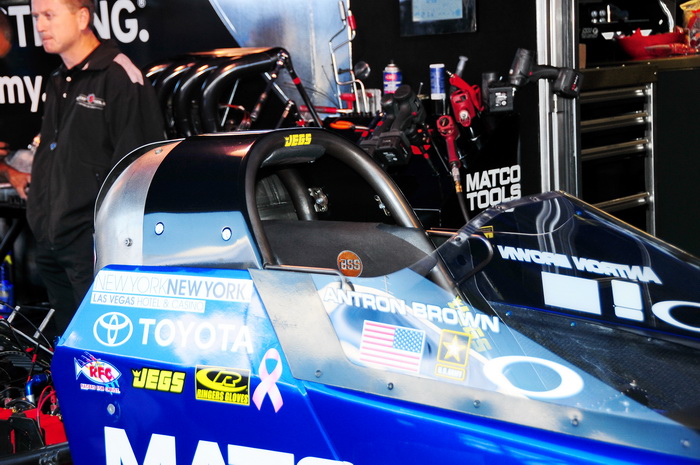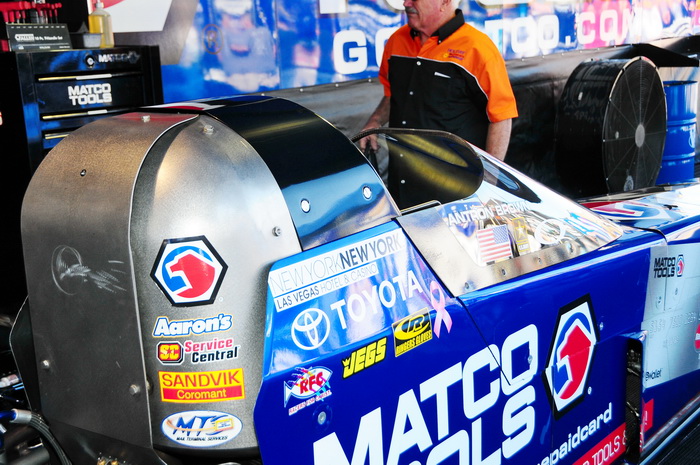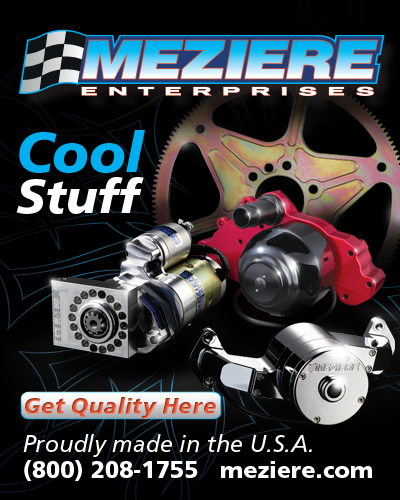NHRA ALLOWS DSR TO USE MODIFIED SHROUDS
 The NHRA ruled Thursday afternoon the three Don Schumacher Racing dragsters can have modified shrouds atop their dragsters beginning at the NHRA Las Vegas Nationals which began Friday.
The NHRA ruled Thursday afternoon the three Don Schumacher Racing dragsters can have modified shrouds atop their dragsters beginning at the NHRA Las Vegas Nationals which began Friday.
“Right now it (the new shroud) it is approved for Vegas and Pomona (Nov. 10-13), and barring anything else it would be approved for all of next year,” Glen Gray, NHRA’s Vice President, Technical Operations told Competition Plus Friday.
Tony Schumacher, Antron Brown and Spencer Massey each had the new shrouds on their DSR dragsters Friday in qualifying The Strip.
 The NHRA ruled Thursday afternoon the three Don Schumacher Racing dragsters can have modified shrouds atop their dragsters beginning at the NHRA Las Vegas Nationals which began Friday.
The NHRA ruled Thursday afternoon the three Don Schumacher Racing dragsters can have modified shrouds atop their dragsters beginning at the NHRA Las Vegas Nationals which began Friday.
“Right now it (the new shroud) it is approved for Vegas and Pomona (Nov. 10-13), and barring anything else it would be approved for all of next year,” Glen Gray, NHRA’s Vice President, Technical Operations told Competition Plus Friday.
Tony Schumacher, Antron Brown and Spencer Massey each had the new shrouds on their DSR dragsters Friday in qualifying The Strip.
On Oct. 14 before qualifying at the NHRA Arizona Nationals in Phoenix the NHRA ruled that it was no longer going to allow the shrouds atop the three Don Schumacher Racing dragsters.
“The shroud that they had in Phoenix actually covered the entire roll cage going back and extended beyond the end of the roll cage, several inches behind the roll cage,” said Gray said. “It had a flat top to it that kind of moved downward after it passed the end of the roll cage. So, it was a much bigger shroud.”
According to Gray, the new approved shrouds are smaller than the ones the three DSR dragsters ran for the first 19 races of the 2010 season prior to Phoenix.
“The (new) shroud that we approved (is one) Mike Green (Tony Schumacher’s crew chief) and I have been working on since Phoenix,” Gray said. “I have been over to their (DSR shop) several times because our NHRA technical headquarters is now in Brownsburg (Ind.) and I am five minutes from their DSR shop. We had several conversations last week about it and talked about different things they wanted to do. They fabricated up some pieces that we looked at (Oct. 27). It (the new shroud) basically just covers the open holes that exist in the front half of the roll cage. So, the purpose of that is that it will help keep things out whether it be fire or other debris out of the cockpit, which we think is a great idea from a safety standpoint. But it does not provide any of the aerodynamic benefits that the other (shroud) did in addition to providing some safety features.”
Green didn’t change his stance about what he thought about DSR’s original shroud.
“Like I said before it is a safety thing,” Green said. “I have never said it was an aerodynamic advantage, they (NHRA) have. It is for sure safer with it on there. We said we are going to make another one and try to make you think that it is not an aero advantage but it still has the safety advantages that we want and we built it and they came to our (DSR) shop last week twice. Glen Gray took pictures and we built three of them (one for each of the DSR dragsters) and they gave us the OK to run it Thursday. Vindication would be putting our original one (shroud) back on. That’s what we think should be on there. We think that is the safest thing. Not having anything on there is definitely nothing any of our (DSR) crew chiefs or drivers wanted.”
Todd Okuhara, the co-chief on Massey’s dragster with Phil Shuler, agreed with Green.
“We just want to make these cars as safe as we can and go out there and run,” Okuhara said. “If we didn’t think it was safer (with the shroud) we wouldn’t have modified it to put it back on.”
Mark Oswald, the co-chief on Brown’s dragster with Brian Corradi, kept NHRA’s latest decision about the shrouds in perspective.
“It is a step,” Oswald said. “I’m sure Don (Schumacher) is still going to be pushing for the full version (the original shroud) because we think it is better safety-wise. It is (a lot of controversy) for a little piece of aluminum. Obviously we ran the cars without it (the original shroud) last week (in Phoenix) and all the cars performed well so it kind of proves it is not really a performance advantage.”
The NHRA, after consultation with two aerodynamic specialists, one of whom they compensated, was told the shrouds had no definitive safety attributes [one suggesting it could be dangerous] and could provide a performance advantage. These studies suggested the shroud could deliver undisturbed air directly into the injector for increased horsepower.
Neither study definitely determined a performance advantage.
“They (Don Schumacher Racing) presented a new concept to our tech department over the winter,” said Graham Light, NHRA’s sr. vice president of operations in an interview with Competition Plus Oct. 14. “It was a shroud over the roll cage. Their intent was to shield the driver from fire coming into the cockpit. The whole concept was for that reason. The windshield … the canopy on the top. It was supposedly a safety innovation to help prevent fire from coming into the cockpit. Based on that intent, the NHRA tech department legalized it.
“It came to the tech department’s attention at Indy, by another team that had gone out and got another aerodynamic engineering company to do an evaluation on this, and what affect it has on airflow, over the cockpit, and what if any advantage that was.”
On Friday, Gray explained the differences between the new shroud and old shroud, which was taken off the DSR dragsters.
“It is quite of bit shorter,” said Gray of the new shroud. “Right now there is a shroud that is on the back half of the roll cage that is mandatory for the drivers and it has been there for several years. The front half, and it is probably a little less than half, it’s probably a third of that roll cage was never covered before. So with this piece they (DSR) had before for the first 19 races it covered that, but it also overlapped and went over the top of the existing back half section. What is there now (with the new shroud) it just covers the open section without extending backwards without overlapping the exiting shroud. That was the portion of the shroud that we became aware of that was providing somewhat of an aerodynamic advantage, cleaning the air up back there and making it a little cleaner going into the injector head. It did provide a safety function because it covered those openings, but this solution we think is much better. I wouldn’t be surprised if some other teams maybe moved to this sort of t hing. No other teams have asked us about running them (the new shrouds). If other teams wanted to run the exact same (DSR) designed piece they would be allowed to do it. This is purely safety. It is not providing any competitive advantage or aerodynamic advantage at all.
NHRA based its latest findings on the new shroud after working with the same aerodynamic specialist who was compensated and whose information they used to disallow the original shroud before Phoenix.
“This is an aerodynamic engineer that we contracted to work with us on these things,” Gray said. “The aerodynamic engineer has a lot of experience and is very well respected. He looked at this and said this is not going to provide any aerodynamic advantage and it will help keep debris and other things out of the cockpit. He will be compensated again this time. What we did was we went to DSR’s shop and took pictures of their exiting cockpit without this on. Because the pieces had not been made yet, Mike (Green) and I worked together to describe what it is going to be and I overlayed the picture so that he (the aerodynamic engineer) could look at the piece. The pieces we saw (Thursday) were exactly as we thought they would be.”
Gray said he submitted the pictures he took at the DSR shop last Friday and the aerodynamic consultant had over the weekend to look at them.
“We got his position on it (the new shroud) this past Tuesday,” Gray said. “I flew in Wednesday (to Las Vegas) and all we had to do was look at the final pieces which the team (DSR) was fabricating and we just wanted to take one last look at that and make sure they were as we thought they would be and they were. I looked at them (the new shrouds) Thursday morning (in Las Vegas). I have a director of engineering he was there to look at them and we also have a competition committee group and we had a quick meeting to discuss the findings from our aero expert, and also our opinions after we had seen the actual parts. About 3 p.m. (Pacific Time) Thursday afternoon we had that final discussion and then I went over and told the team that they were approved. Mike (Green) was not here, so I sent him an email telling him they were approved. In my email to Mike (Thursday), I commented to him to please let me know if you are going to make any changes to the piece that we have approved now.”
Green definitely isn’t done with the shroud project.
“We want to make something even safer,” Green said. “I do not know if next year we will run the original one, but we want to make something that works better. We kind of learned this one (the original shroud). This was the first one we ever made and we ran it this year and saw some pressure differences and stuff that we had hoped to learn, and I think we can make a better one. I would look to see us have something different for next year. Now, whether NHRA will allow us to do it that is another question.”
Gray isn’t about to make any decisions on what future shrouds DSR plans on making.
“Not knowing what DSR is proposing and what they are looking at, I can’t really give you an answer on that,” Gray said. “Many of the teams are submitting things to us all the time, and we just have to review them and take a look at them and look at their merits and their advantages and disadvantages.”






































